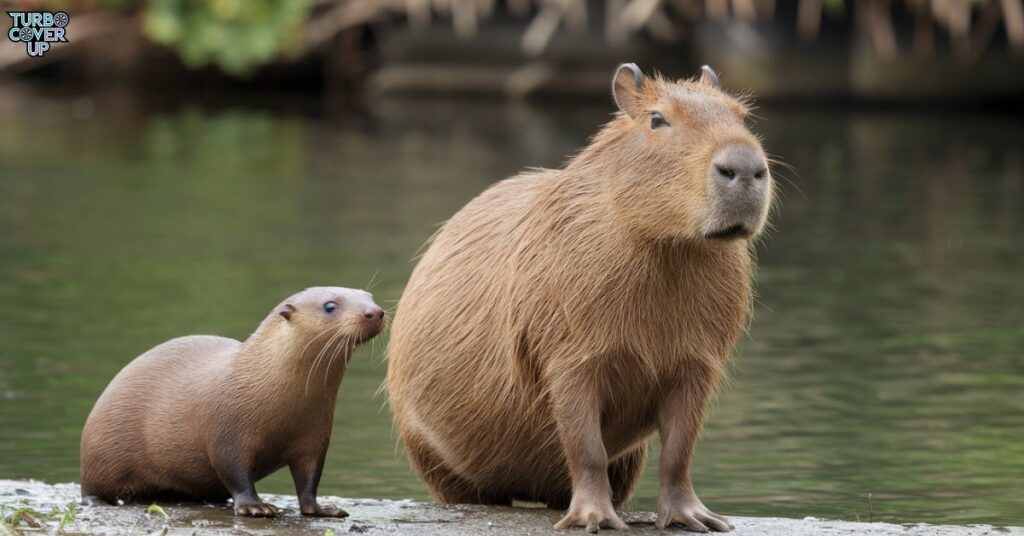When it comes to intriguing creatures in the animal kingdom, few are as captivating as the capybara and the nutria. Both belong to the rodent family and share similar habitats and diets, but they are remarkably different in various aspects.
In this article, we’ll discuss the capybara vs. nutria debate, shedding light on their behaviours, social structures, physical characteristics, and more.
Main Key Differences
At first glance, you might confuse a capybara with a nutria. After all, they both enjoy aquatic environments and have similar diets. However, several key distinctions set them apart.
Overview of Capybaras and Nutrias
- Capybara: Known as the largest rodent in the world, the capybara is native to South America. They thrive in groups and are often seen lounging in water or grazing on grass.
- Nutria: Also called coypu, the nutria is smaller than the capybara and native to South America as well, but they have spread to various parts of the world, including North America and Europe. Nutrias are less social and tend to be more solitary.
You Might Also Like: Wolverine Animal Size to Human
Size Comparison

Understanding the capybara size compared to nutria size is essential in recognizing their differences.
| Feature | Capybara | Nutria |
| Average Weight | 77 to 150 lbs (35 to 66 kg) | 10 to 20 lbs (4.5 to 9 kg) |
| Length | 3.5 to 4.5 feet (1.1 to 1.4 m) | 2 to 2.5 feet (0.6 to 0.76 m) |
| Height | About 2 feet (0.6 m) | About 1.5 feet (0.46 m) |
Social Structures
Both capybara social behavior and nutria social structure exhibit notable differences.
- Capybaras: These rodents are extremely social creatures. They live in groups that can range from 10 to 20 individuals, although groups of up to 100 have been observed. Their social dynamics are essential for their survival, as they rely on each other for protection from predators.
- Nutrias: In contrast, nutria behavior tends to be more solitary. They often live in small family units or alone, making their interactions less complex than those of capybaras. They are more territorial and will defend their area against other nutrias.
Temperament and Aggressiveness
- Capybaras are known for their friendly and calm nature. They can often be found socializing with other animals, including birds and even domestic pets.
- Nutria, on the other hand, can be defensive and aggressive, especially when threatened. They have sharp teeth and can bite if they feel cornered or endangered.
Environmental Impact
Another significant aspect of the capybara vs. nutria debate is their respective impacts on the environment.
- Capybaras generally have a positive effect on their ecosystems. They help maintain wetland areas by grazing on grass and are essential for the balance of local flora and fauna.
- Nutrias, however, can be invasive. In places where they have been introduced, they often damage wetlands and crops, leading to significant ecological concerns. Their burrowing habits can undermine levees and riverbanks, causing erosion.
Comparative Table
A comparative table helps to visualize the capybara nutria differences more clearly.
| Feature | Capybara | Nutria |
| Scientific Name | Hydrochoerus hydrochaeris | Myocastor coypus |
| Habitat | Wetlands, savannas, and grasslands | Marshes, rivers, and lakes |
| Diet | Primarily herbivorous (grasses) | Herbivorous but also consumes aquatic plants |
| Reproduction | Breeds year-round, 4-5 young | Breeds year-round, 4-6 young |
| Lifespan | 8-12 years in the wild | 5-7 years in the wild |
| Conservation Status | Least Concern | Least Concern |
You Might Also Like: Whale Shark Compared to Human
Behavior
The behavior of capybaras and nutrias showcases their adaptations to their environments.

Daily Activities
Capybaras typically spend their days grazing on grass and foraging for food. They are diurnal, meaning they are active during the day.
Nutria tend to have more varied activity patterns, often being crepuscular (active during dawn and dusk). They spend much of their time foraging for food, primarily aquatic plants and grasses.
Habitat Preferences
- Capybara Habitat: They prefer areas with plentiful water, such as lakes, rivers, and wetlands. These habitats provide not just food, but also a place to escape from predators.
- Nutria Habitat: Nutrias are more adaptable and can thrive in various aquatic environments, including urban areas. Their ability to live in a range of habitats contributes to their invasive nature in places outside their native range.
Personality
Understanding the personality traits of these rodents can provide insight into their behavior and social structures.
General Temperament
- Capybaras are renowned for their friendly and laid-back personalities. They are often described as sociable, and their calm demeanor makes them popular in petting zoos and as exotic pets.
- Nutrias, in contrast, can be shy and cautious. They are less likely to approach humans and prefer to remain hidden in their habitats.
Adaptation to Domestic Life
Many people consider keeping capybaras as pets due to their friendly nature, but potential owners should be aware of their social needs and space requirements. Capybaras thrive in groups and require plenty of water to swim in.
Nutrias are less commonly kept as pets. Their solitary and territorial nature can make them challenging to domesticate. Moreover, they can be destructive and are not suited for every home environment.
Intelligence
Cognitive Abilities
When it comes to intelligence, both rodents display unique abilities suited to their lifestyles.
- Capybaras: Known for their problem-solving skills, they exhibit a level of intelligence in social situations, which aids their survival in groups. They can learn to recognize individuals and respond to various social cues.
- Nutrias: While perhaps not as socially intelligent as capybaras, nutrias exhibit adaptive intelligence, allowing them to find food and avoid predators in different environments. Their foraging strategies demonstrate their ability to navigate complex ecosystems.
Swimming Power
Both capybaras and nutrias are adept swimmers, but they showcase different abilities.
Aquatic Skills
- Capybaras are semi-aquatic, often taking to the water to escape predators or cool off. Their webbed feet enable them to swim efficiently, and they can remain submerged for up to five minutes at a time.
- Nutrias are also strong swimmers, thanks to their webbed feet and streamlined bodies. They are equally comfortable in the water, using it to escape threats and find food.
Running Speed
Land Speed
In terms of land mobility, both species possess impressive speed but in different contexts.
- Capybaras can reach speeds of up to 35 mph (56 km/h) when necessary, especially when escaping predators. They rely on their social structure to warn each other of impending danger.
- Nutrias, while smaller, can also move quickly when needed, reaching speeds up to 20 mph (32 km/h). Their agility helps them navigate through dense vegetation and avoid threats.
Body Language
Understanding the body language of these rodents can reveal a lot about their emotional states and interactions with others.
Communication Styles
- Capybaras use a combination of vocalizations and body language to communicate. They may squeal, bark, or make purring sounds, especially during social interactions. Their body language can indicate comfort or distress.
- Nutrias tend to communicate more subtly, using body posture and movements. They may thump their feet as a warning signal or retreat into the water when feeling threatened.
Behavioral Examples
- When capybaras are relaxed, they often lie down or groom each other, showing a strong bond within their social groups.
- Nutrias may engage in grooming as well, but their interactions are less frequent and usually involve direct family members.
Conclusion
The capybara vs. nutria comparison reveals fascinating insights into these unique rodents. From their social structures and behavior patterns to their habitats and physical traits, understanding the distinctions between capybaras and nutrias provides a deeper appreciation for these creatures.
Both species play significant roles in their respective ecosystems, with capybaras generally having a more positive impact compared to the often invasive nutrias. As we continue to study these remarkable rodents, it’s crucial to respect their habitats and promote conservation efforts.
Frequently Asked Questions
What is the main difference between a capybara and a nutria?
The main difference is their size and social behaviour. Capybaras are much larger and live in groups, while nutrias are smaller and tend to be more solitary.
Are capybaras friendly animals?
Yes, capybaras are known for their friendly and social nature. They often get along well with other animals and enjoy the company of their kind.
Can nutrias be kept as pets?
While it’s possible to keep nutrias as pets, they can be shy and territorial. They are less suitable as pets compared to capybaras, which are more social and easier to manage.
How do capybaras and nutrias communicate?
Capybaras use vocalizations and body language to communicate with each other. Nutrias communicate more subtly, using body posture and occasional sounds.
What are the habitat preferences of capybaras and nutrias?
Capybaras prefer wetlands, rivers, and grasslands, while nutrias can thrive in various aquatic environments, including urban areas. Both animals enjoy areas with plenty of water and vegetation.

